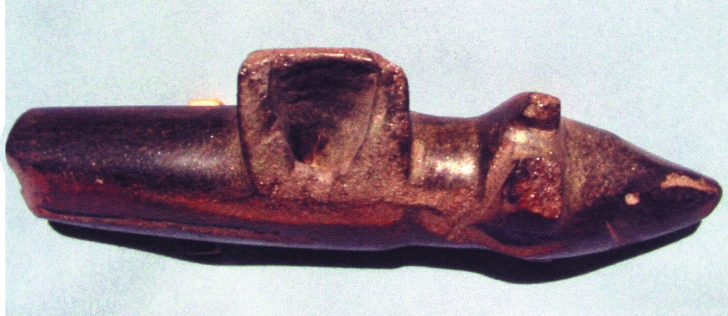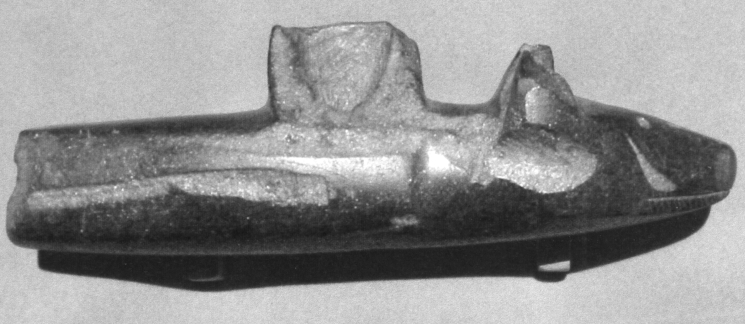|
NOT TOO MUDDY FOR TEE AND BILL
|
Bill Mesnard
|
| Central States Archaeological Societies 2003
Fall Journal |
Califon, New Jersey
|
On a cold damp November day in 1998, Tee Shores and her sister, Bill decided to go looking for arrowheads. Earlier
in May, Bill's pony had gotten spooked and fell on her, breaking both of her legs. This would be her first time
looking for arrowheads since then, but she would have to use crutches. They were looking in one of their favorite
spots in Coffee County, Tennessee, in a large open field which gently slopes down toward a creek. The creek has
the distinction of starting from adjacent twin caves out of the side of a mountain. It was muddy and Bill was having
a tough time.
Tee called Bill over as she found a heavy foot-long ornament from the front of a tractor in a washed out ditch.
It had a hole in it and she through it back. This field is quite generous with producing Adena spear points which
average 2 1/2 inches in length. Having hunted arrowheads for fifty years, Tee retraced her steps and picked up
the ornament again, this time wiping off more of the mud. It was a magnificent Great Pipe, 11 1/2 inches long,
weighing 3 1/2 pounds and made of greenish brown steatite sprinkled with mica inclusions. There is a nearly pure
mica vein running across the right face into the ear of the Copena wolf effigy and a larger vein in the stem. But,
the heavily muscled jaw, boxy ears coming off on top of the head, makes this look like more of a bear than a wolf
effigy. The eyes were drilled about a 1/4 of an inch and then individually shaped, probably to accept pearls. There
is a small amount of hair etched on the face and the mouth is a deeply incised line with etching below suggesting
teeth. The deep polish of its face and neck gives way to a slightly lighter polish elsewhere. Unfortunately, modern
farming left several plow scars; some are deep and go nearly the length of the pipe. There is a small amount of
ancient damage to the mouth piece, but a large amount to the bowl, such that only about 1/3 of it is still fully
present above the bear's head. The large bowl was drilled with a hardwood stick one inch in diameter whose cone
shape is still present in the body. The inside of the bowl was then further gouged out to 1 1/2 inches to make
it more rectangular in keeping with its rectangular outline which rises 1 3/8 inches above the body. The mouth
piece and bowl damage was partially smoothed and polished, but this light polish is not nearly as deep as the original
polish. The stem hole is 3/4 inch in diameter, gradually and evenly tapering to 5 1/16 inch approximately 4 1/2
inches later where it meets the bowl, slightly off center. The first 1 inch is smoothed, but there the circling
drill marks along with spiraling gouge marks can be seen.
This handsome pipe has such spirit that it is little wonder it was repaired and continued to be used in ceremonies
of the bear clan. The size heft, and large bowl suggest to me that it would take 10 to 20 persons to properly use
such a pipe. This classic Southern "Great Pipe" made in the Woodland time period by the Copena culture,
which centers in Tennessee and extended into Kentucky and Alabama. Gehlbach* mentions that five similar pipes were
also found in the largest of the Seip Mounds in Ross County, Ohio, and were dated 300 to 400 AD. These fine effigy
pipes were of an owl, a whippoorwill or night hawk, a bear, a dog or wolf, and lastly, a dog eating a man's head.
It is felt that these five pipes were made in Tennessee and were trade items from the Copena to the Hopewell of
Ohio.
REFERENCE
Gehlbach, Donald
1998 Ohio's Prehistoric Pipes. Published by the author.
|

|
|
Magnificent Great Pipe measuring 11 1/2 inches in length and weighing 3 1/2 pounds. This beautiful
Copena wolf effigy was found by Tee Shores in Coffee County, Tennessee.
|
|

|
|
|




